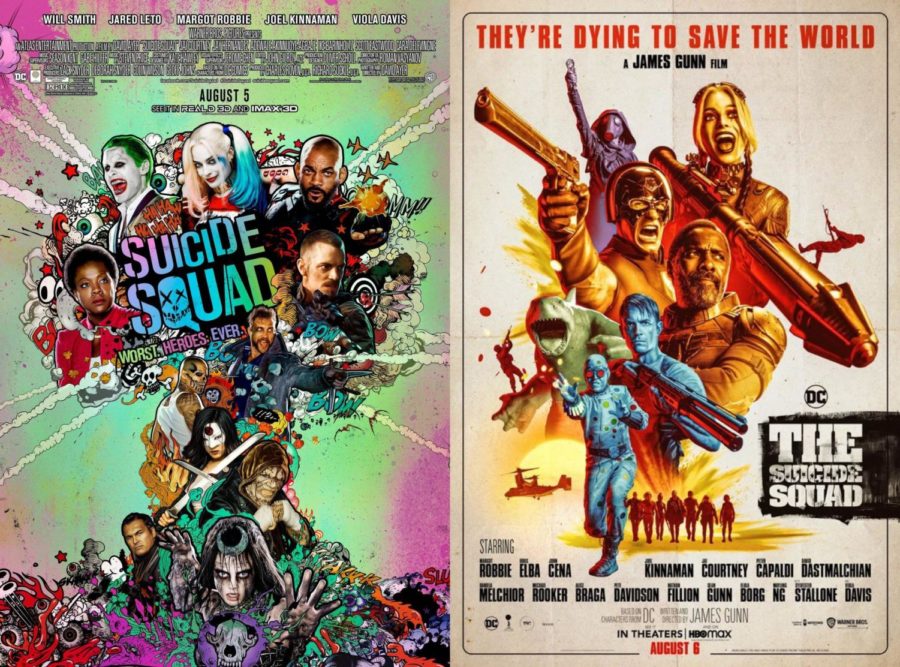Suicide Squad: 5 Years Later
The posters for David Ayer’s Sucicide Squad (2016), and James Gunn’s The Suicide Squad (2021) side-by-side. I’d rate Suicide Squad 4/10. I’ll gladly rate The Suicide Squad a 9/10.
October 4, 2021
Suicide Squad was bad. This isn’t a particularly new or controversial opinion for most who’ve seen the movie. With a 26% score on Rotten Tomatoes, the film was a critical flop, to put it lightly. So when comic book movie fans and critics caught wind of a sequel, many were expecting it to be the same if not worse than the original, a common trait of sequels. They couldn’t have been any more wrong. Despite underperformance at the box office, The Suicide Squad (2021) was a hit among fans and critics alike, achieving a 91% score on Rotten Tomatoes and far surpassing 2016’s mishap.
DISCLAIMER: Spoilers inbound!
The Suicide Squad comics, published by DC, follow a team of incarcerated supervillains, dubbed “Task Force X” in more recent iterations, tasked with black ops missions to neutralize superhuman threats to society in exchange for reduced prison sentences or other benefits, but implanted with explosive devices in the event that they go rogue, directed by Amanda Waller. A compelling premise with infinite storytelling and character potential due to the sheer amount of villains in DC Comics, it was inevitable that these stories would hit the silver screen.
Suicide Squad is a 2016 film released in U.S. theaters on 5 August 2016, based on the comics of the same name. Written and directed by David Ayer, it follows Task Force X, consisting of Harley Quinn (Margot Robbie), Deadshot (Will Smith), El Diablo (Jay Hernandez), Captain Boomerang (Jai Courtney), Killer Croc (Adewale Akinnuoye-Agbaje), and Slipknot (Adam Beach), led by Colonel Rick Flag (Joel Kinnaman) with Katana (Karen Fukuhara), and commanded by Amanda Waller (Viola Davis). The squad is tasked with defeating Enchantress (Cara Delevingne), who has possessed the body of archaeologist June Moone (with whom Flag has a secret infatuation), and threatens to destroy humanity. Also present is Jared Leto’s now infamous portrayal of the Joker.
But why was 2016’s squad so bad? It really comes down to the way the film attempts to give compelling backstories and characterization to more than eight core characters, many of whom the audience has never seen before and knows nothing about. This, coupled with the two-hour time limit to satisfyingly conclude each character arc and plot point, leads to a mess of bad pacing and underdeveloped characters.
This stands in stark contrast with James Gunn’s The Suicide Squad, which hit U.S. theaters exactly five years after the original, and serves as a standalone sequel to Ayer’s. At the start of the film, it seemed like it would suffer the same fate of a bloated main cast, with Robbie, Courtney, and Kinnaman reprising their roles along with five other team members all introduced at once. That was until most of the squad were brutally massacred in graphic detail (I told you there were going to be spoilers), earning a very hard “R” rating right off the bat. The film then shows that the aforementioned group was a mere decoy to allow a second Task Force X consisting of King Shark (Sylvester Stallone), Ratcatcher 2 (Daniela Melchior), Polka-Dot Man (David Dastmalchian), Peacemaker (John Cena), and Bloodsport (Idris Elba). This smaller core cast allows for more natural interactions between the whole team and thus, more substantial character growth. Later on, they are joined by Quinn and Flag, who survived the decoy mission, and round out the squad.
Characterization is the biggest part of what makes The Suicide Squad a far superior experience to Suicide Squad. One thing this film does beautifully is give substantial screen time and depth to seemingly ridiculous one-off characters like the Polka-Dot Man. His burning hatred for his mother and the disease that gives him his powers are played for numerous laughs, but give him far more character than anyone expected from a villain defined by his ability to shoot polka dots. Gunn’s writing also created an interesting dichotomy between Bloodsport and Peacemaker, two former mercenaries with nearly the same exact backstory and a very similar set of skills: using practically anything as a deadly weapon. The two are distinguished by and clash due to their ideologies, the former being a stern yet compassionate father, with the latter being an ultra-utilitarian claiming himself to “[love] peace so much, that [he] doesn’t care how many men, women, and children [he] has to kill to get it.”Suicide Squad was bad. The Suicide Squad was fantastic. The DC Extended Universe (DCEU) has had very mixed reception since its inception, with films like Man of Steel (2013), Batman v. Superman: Dawn of Justice (2016), the film that I’ve been trashing on since the start of this article (2016), and Justice League (2017) seemingly cementing the franchise as massive budgets wasted on mediocre movies. However, with newer installations in the series like Shazam! (2019), Birds of Prey (2020), Zack Snyder’s Justice League (2021) (the Snyder Cut), and the focus of this entire article (2021), the DCEU seems to be finding its footing and might actually contend against the Marvel Cinematic Universe (MCU) sometime in the future.


